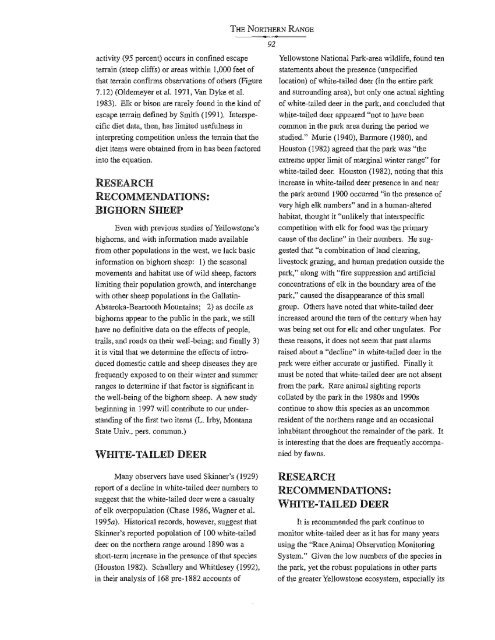Yellowstone's Northern Range - Greater Yellowstone Science ...
Yellowstone's Northern Range - Greater Yellowstone Science ...
Yellowstone's Northern Range - Greater Yellowstone Science ...
Create successful ePaper yourself
Turn your PDF publications into a flip-book with our unique Google optimized e-Paper software.
THE NORTHERN RANGE<br />
92<br />
activity (95 percent) occurs in confined escape<br />
terrain (steep cliffs) or areas within 1,000 feet of<br />
that terrain confirms observations of others (Figure<br />
7.12) (Oldemeyer et al. 1971, Van Dyke et al.<br />
1983). Elk or bison are rarely found in the kind of<br />
escape telTain defined by Smith (1991). Interspecific<br />
diet data, then, has limited usefulness in<br />
interpreting competition unless the terrain that the<br />
diet items were obtained from in has been factored<br />
into the equation.<br />
RESEARCH<br />
RECOMMENDATIONS:<br />
BIGHORN SHEEP<br />
Even with previous studies of <strong><strong>Yellowstone</strong>'s</strong><br />
bighorns, and with information made available<br />
from other populations in the west, we lack basic<br />
information on bighorn sheep: 1) the seasonal<br />
movements and habitat use of wild sheep, factors<br />
limiting their population growth, and interchange<br />
with other sheep populations in the Gallatin<br />
Absaroka-Beartooth Mountains; 2) as docile as<br />
bighorns appear to the public in the park, we still<br />
have no definitive data on the effects of people,<br />
trails, and roads on their well-being; and finally 3)<br />
it is vital that we determine the effects of introduced<br />
domestic cattle and sheep diseases tlley are<br />
frequently exposed to on their winter and summer<br />
ranges to determine if that factor is significant in<br />
the well-being of the bighorn sheep. A new study<br />
beginning in 1997 will contribute to our understanding<br />
of the first two items (L. Irby, Montana<br />
State Univ., pers. commun.)<br />
WHITE-TAILED DEER<br />
Many observers have used Skinner's (1929)<br />
repOlt of a decline in white-tailed deer numbers to<br />
suggest that the white-tailed deer were a casualty<br />
of elk overpopulation (Chase 1986, Wagner et al.<br />
1995a). Historical records, however, suggest that<br />
Skinner'S reported population of 100 white-tailed<br />
deer on the northern range around 1890 was a<br />
short-term increase in the presence of that species<br />
(Houston 1982). Schullery and Whittlesey (1992),<br />
in their analysis of 168 pre-1882 accounts of<br />
<strong>Yellowstone</strong> National Park-area wildlife, found ten<br />
statements about the presence (unspecified<br />
location) of white-tailed deer (in the entire park<br />
and surrounding area), but only one actual sighting<br />
of white-tailed deer in the park, and concluded that<br />
white-tailed deer appeared "not to have been<br />
common in the park area during the period we<br />
studied." Murie (1940), Barmore (1980), and<br />
Houston (1982) agreed that the park was "the<br />
extreme upper limit of marginal winter range" for<br />
white-tailed deer. Houston (1982), noting that this<br />
increase in white-tailed deer presence in and near<br />
the park around 1900 occurred "in the presence of<br />
very high elk numbers" and in a human-altered<br />
habitat, thought it "unlikely that interspecific<br />
competition with elk for food was the primary<br />
cause of the decline" in their numbers. He suggested<br />
that "a combination of land clearing,<br />
livestock grazing, and human predation outside the<br />
park," along with "fire suppression and artificial<br />
concentrations of elk in the boundary area of the<br />
park," caused the disappearance of this small<br />
group. Others have noted that white-tailed deer<br />
increased around the turn of the century when hay<br />
was being set out for elk and other ungulates. For<br />
these reasons, it does not seem that past alarms<br />
raised about a "decline" in white-tailed deer in the<br />
park were either accurate or justified. Finally it<br />
must be noted that white-tailed deer are not absent<br />
from the park. Rare animal sighting reports<br />
collated by the park in the 1980s and 1990s<br />
continue to show this species as an uncommon<br />
resident of the northern range and an occasional<br />
inhabitant throughout the remainder of the park. It<br />
is interesting that the does are frequently accompanied<br />
by fawns.<br />
RESEARCH<br />
RECOMMENDATIONS:<br />
WHITE-TAILED DEER<br />
It is recommended the park continue to<br />
monitor white-tailed deer as it has for many years<br />
using the "Rare Animal Observation Monitoring<br />
System." Given the low numbers of the species in<br />
the park, yet the robust popUlations in other parts<br />
of the greater <strong>Yellowstone</strong> ecosystem, especially its















